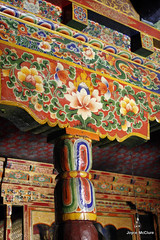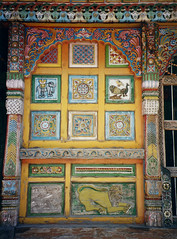 Hindu wooden temple Chergaon Chamba, in Himalaya, Himachal Pradesh, India
Hindu wooden temple Chergaon Chamba, in Himalaya, Himachal Pradesh, IndiaI will keep on adding to this post.
Temple at Chergaon, Himalaya
Mountain magic Temples of Himalayas, in Jammu & Kashmir and Himachal
Himachal

 Old Hindu Temple in Shimla, Himachal Pradesh, India.
Old Hindu Temple in Shimla, Himachal Pradesh, India.Maheshwar Temple in Sungra, Kinnaur, Himachal Pradesh, India

Wood carving at a temple in Sangla, Himachal Pradesh, India. Photo by Harish Kapadia.
American Alpine Club Library

Temple in Himachal Pradesh Saijn, India. Photo by Harish Kapadia. Photo credits to American Alpine Club Library at Flickr. American Alpine Club Library
Norway - Vatnås Kirke
Painted decorations in Vatnås church in Buskerud county in Norway. The old Norwegian traditional decor paintings called "rosemaling" resembles the decoration in many Asian Buddhist temples or shrines.
The décor paintings in Vatnås church in Buskerud, Norway are likely inspired from the old medieval church building. The present Vatnås church was built in 1660 after the Lutheran reformation, a religious revolt that was supported from Germany in the early part of 1500‘s. The Lutheran reformation involved a break in religious tradition from the old medieval catholic religion that had allowed worshipping of the ancient pre-Christian religion in the Nordic, including Norway. However, as seen in this and other Nordic churches, the earlier traditions inspired the new colonizers.
Temple in Kalpa, Kinnaur, Himachal Pradesh, India
Originally uploaded by east med wanderer
Buddhist painting Likir Monastery Ladakh India

Carved and painted beam and walls in Likir Monastery in Ladakh District, India
Originally uploaded by Joyce McClure
Shrine in Bhutan
ARCHITECTURE in India
WOODEN ARCHITECTURE in India Take a closer look at the architecture in India and Himachal Pradesh
Wooden Temples of Himachal Pradesh by Mian Goverdhan Singh
Temples In Uttarkashi
History of Indian and Eastern architecture, 1910
History Speaks
Temples in Kinnaur
Wood Carved Ceiling, Lakshna Devi Temple at Bharmaur, c.700 CE
Stavkirker in the Nordic Areas
Stave Churches are in some instances rebuilt ancient heathen temples and some built over Heathen Temples with heathen styles. The original structures were simpler and of course without the christian ornamentation. You can see larger versions by clicking on the pictures.


Interesting about the Norwegian Stave Churches or Stavkirker is the heathen i.e. pre-Christian ornamentation used, such as for instance lions on pillars, serpent and tree worship, engravings of third eye, dragons etc. Most of the Stave Churches are rebuilt and restored and new are built over or attached to the old ones. In some cases there are found remains of old heathen temples under some of these churches, and even gold leafs that were used for "heathen" offerings. In a more recent posting I have written more about golden leafs or gold foil offerings from Iron Age Norway and Sweden, and from Buddhist India and Pakistan.
In the photos over you there are two old churches, the one in Hopperstad is under restoration. You can see the old structure in these. Some of the Stave Churches might have been heathen temples. Tremendous efforts have been done to destruct or redefine the pre-Cristian religions of the Nordic. The relatively late Christian colonization history in the Nordic areas is still silenced.
 Urnes Stavkirke, Norway. Click on the picture.
Urnes Stavkirke, Norway. Click on the picture.  Urnes Stavkirke, Norway. Click on the picture.
Urnes Stavkirke, Norway. Click on the picture.  Borgund stave church in Lærdal, Norway. Source: Wikipedia. Photograph by Nina Aldin Thune
Borgund stave church in Lærdal, Norway. Source: Wikipedia. Photograph by Nina Aldin ThuneHyperlinked photos of Norwegian Stavkirker (Language of the site is in Norwegian).
Stavkirke
Middelalderens Stavkirker (Medieval Stavkirker). 28 are preserved and are from after 1100 CE. The Nordic were nominally Christianised between 1000 – 1200 CE. In reality people did not convert easily to Christianity in the Nordic areas. Likely, many of the ancient Stavkirker was kept in old heathen traditional Nordic style. Stave churches or Stavkirker in Norway were inspired by and several were built over heathen temples
Stave Churches
 Heddal Stavkirke in Norway.
Heddal Stavkirke in Norway.

Gol Stavkirke in Norway. The first photo from Wikimedia is by smial (1976) and the winter scene is by agtfjott 2005


The ceiling of Fantoft Stavkirke, in Bergen Norway. The first Wikimedia photo is by Lm-berlin (2007) and the next is by tu og polarlys (2006)
Asia:
 Temple of Jyeshteswara, Shankaracharya temple, on the Takht-i-Suliman Hill, near Srinagar. Probable date 220 BCE. Kashmir. Temple of Jyeshteswara or Shankaracharya, on the Takht-i-Suliman Hill, near Srinagar. Probable date 220 BCE. A Shiva temple.
Temple of Jyeshteswara, Shankaracharya temple, on the Takht-i-Suliman Hill, near Srinagar. Probable date 220 BCE. Kashmir. Temple of Jyeshteswara or Shankaracharya, on the Takht-i-Suliman Hill, near Srinagar. Probable date 220 BCE. A Shiva temple. Cunningham Mauryan building in the Barabar Mounts, India. Grottoe of Lomas Rishi. 3 rd century BCE. Asokan Era. The Barabar Caves dates back to the Maurya Era (322–185 BCE) and inscriptions of Ashoka (264-225 BCE) are found in these caves in the district of Gaya, India. More photos can be seen in the added site.
Cunningham Mauryan building in the Barabar Mounts, India. Grottoe of Lomas Rishi. 3 rd century BCE. Asokan Era. The Barabar Caves dates back to the Maurya Era (322–185 BCE) and inscriptions of Ashoka (264-225 BCE) are found in these caves in the district of Gaya, India. More photos can be seen in the added site. Relief from Bharhut, Madhya Pradesh, India. Likely Mauryan. These dates back to about 150 BCE.
Relief from Bharhut, Madhya Pradesh, India. Likely Mauryan. These dates back to about 150 BCE. Kashmir. Sun worship temple, near Bhawan. Likely date to 490-555 CE. Surya Temple at Martand in Jammu – Kashmir. Photo by John Burke in 1868.
Kashmir. Sun worship temple, near Bhawan. Likely date to 490-555 CE. Surya Temple at Martand in Jammu – Kashmir. Photo by John Burke in 1868. Shankaragaurishvara temple at Patan, on the road between Srinagar and Baramula view of the front or west face. Shankaragaurishvara dates to 800-900 CE. Shiva temple. Kashmir.
Shankaragaurishvara temple at Patan, on the road between Srinagar and Baramula view of the front or west face. Shankaragaurishvara dates to 800-900 CE. Shiva temple. Kashmir.Scandinavia:
The following are Swedish stone churches, that have been rebuilt in the course of history, the most ancient parts of these churches are interesting in relation to the old heathen culture of the ancient Nordic Goths.
 The entrance portal on the south side of the church of Stånga on Gotland, Sweden. This church is said to be built in the 1300-eds but contains some older parts from 1200eds.
The entrance portal on the south side of the church of Stånga on Gotland, Sweden. This church is said to be built in the 1300-eds but contains some older parts from 1200eds.
Gotland-Bro-kyrka built in the 1100 eds. Photo by Jürgen Howaldt, 2005
Remains of the Pre-Christian Religion in Swedish Churches:
 Remains of a heathen religious ornamental stone (Bildsten) built in the wall of a newer Swedish stone church. Bro Church at Gotland, Sweden, photo by Jürgen Howaldt, 2005. Parts of this church are much older than the Christian Medieval period. It is said that the church was built in 1100 CE, in a period when heathen traditions still was practiced in Sweden. All of Sweden was not Christianised that early. It seems like the Christianising of Sweden and the Nordic seems to involve confusing the old history with the newer history, in an effort to wipe away remains of the past, the old religion and history.
Remains of a heathen religious ornamental stone (Bildsten) built in the wall of a newer Swedish stone church. Bro Church at Gotland, Sweden, photo by Jürgen Howaldt, 2005. Parts of this church are much older than the Christian Medieval period. It is said that the church was built in 1100 CE, in a period when heathen traditions still was practiced in Sweden. All of Sweden was not Christianised that early. It seems like the Christianising of Sweden and the Nordic seems to involve confusing the old history with the newer history, in an effort to wipe away remains of the past, the old religion and history.In 2001 the Taliban destroyed the Buddhas of Bamyan in Afghanistan, it shocked most people around the globe and a part of the ancient world heritage is lost forever. Also in the Nordic ancient religion have been destroyed, but generally in a much slower and relatively systematic way. Confused dating and redefinition of ownership seems to have been one of several common tactics in destroying and redefining of the ancient pre-Christian religion and history in the Nordic areas. It seems that Bro Church in Gotland is an excellent example, which I will return to later.
 A pre-Christian Runic stone integrated in the wall of Roslagsbro church (Roslagsbro kyrka), Sweden. Photo by berig, 2008.
A pre-Christian Runic stone integrated in the wall of Roslagsbro church (Roslagsbro kyrka), Sweden. Photo by berig, 2008. Remains of a Lancet or pointed arch from Björsäter Church in Västergotland in Sweden. Photo from YlvaS Flickr, 2006. Creative commons license.
Remains of a Lancet or pointed arch from Björsäter Church in Västergotland in Sweden. Photo from YlvaS Flickr, 2006. Creative commons license. Portal of Sankt Olofs Church in Falköping, Sweden. Church dates to 1100 CE. Photo by Harri Blomberg, 2006
Portal of Sankt Olofs Church in Falköping, Sweden. Church dates to 1100 CE. Photo by Harri Blomberg, 2006 Sankt Olofs kyrka in Falköping, Sweden, oldest part 1100 CE, photo by Harri Blomberg, 2006.
Sankt Olofs kyrka in Falköping, Sweden, oldest part 1100 CE, photo by Harri Blomberg, 2006. Sankt Olofs Church in Falköping, Sweden. Photo by Harri Blomberg, 2006. Oldest part built 1100 CE.
Sankt Olofs Church in Falköping, Sweden. Photo by Harri Blomberg, 2006. Oldest part built 1100 CE. From Tumbo in Södermanland. Sveriges runinskrifter III. Stockholm Kungl. Vitterhets Historie och Antikvitets Akademien.
From Tumbo in Södermanland. Sveriges runinskrifter III. Stockholm Kungl. Vitterhets Historie och Antikvitets Akademien.Tumbo Church in Strängnäs, Södermanland, Sweden. Near the church there is six runic stones. The choir has a round wall (absidform) that is from 1100-eds. It is told in the linked site that exact dating is difficult. Only five tree beams were possible to date, and these were from 1100 to mid-1100. As I see it part of this church might have been a heathen i.e. Pre-Christian temple. Some more photos of the church can be seen in the URL.
 Gamla uppsala Church in Sweden, the tower belonged to the old church, Photo by OlofE, 2003.
Gamla uppsala Church in Sweden, the tower belonged to the old church, Photo by OlofE, 2003. Plan over Gamla Uppsalas old church, Sweden. The choir is original from the old church.
Plan over Gamla Uppsalas old church, Sweden. The choir is original from the old church. Fighting with reptiles. Kungslena Church, Sweden, Photo by Harry Blomberg, 2006 Västgöten.
Fighting with reptiles. Kungslena Church, Sweden, Photo by Harry Blomberg, 2006 Västgöten. Old and newer parts of Lund Cathedral in Sweden. The older parts are from about late 1000 to 1100 CE.
Old and newer parts of Lund Cathedral in Sweden. The older parts are from about late 1000 to 1100 CE.


Absolut fantastic
ReplyDelete